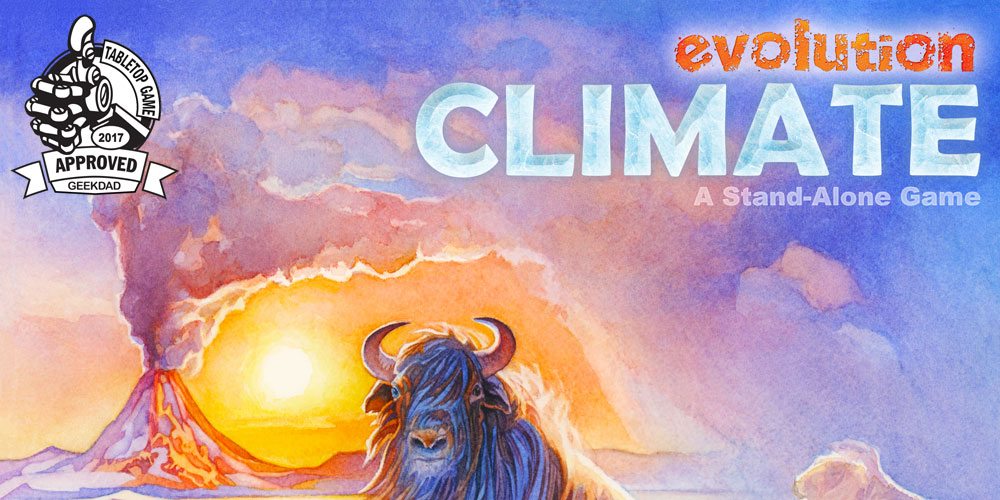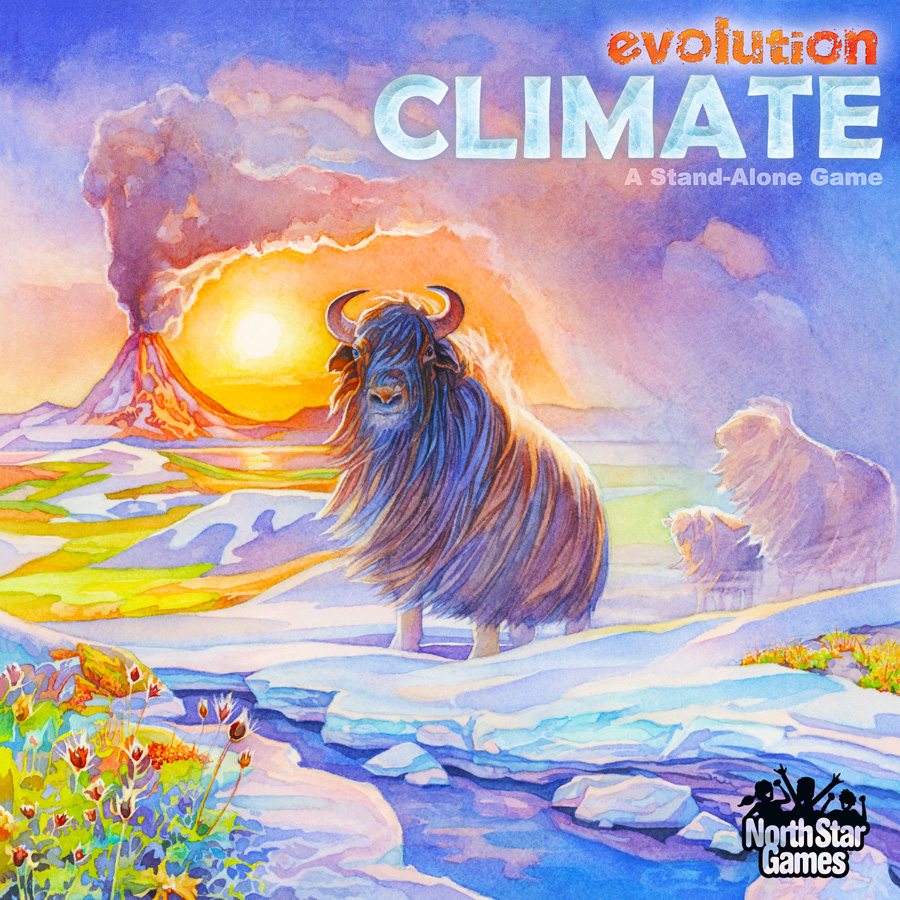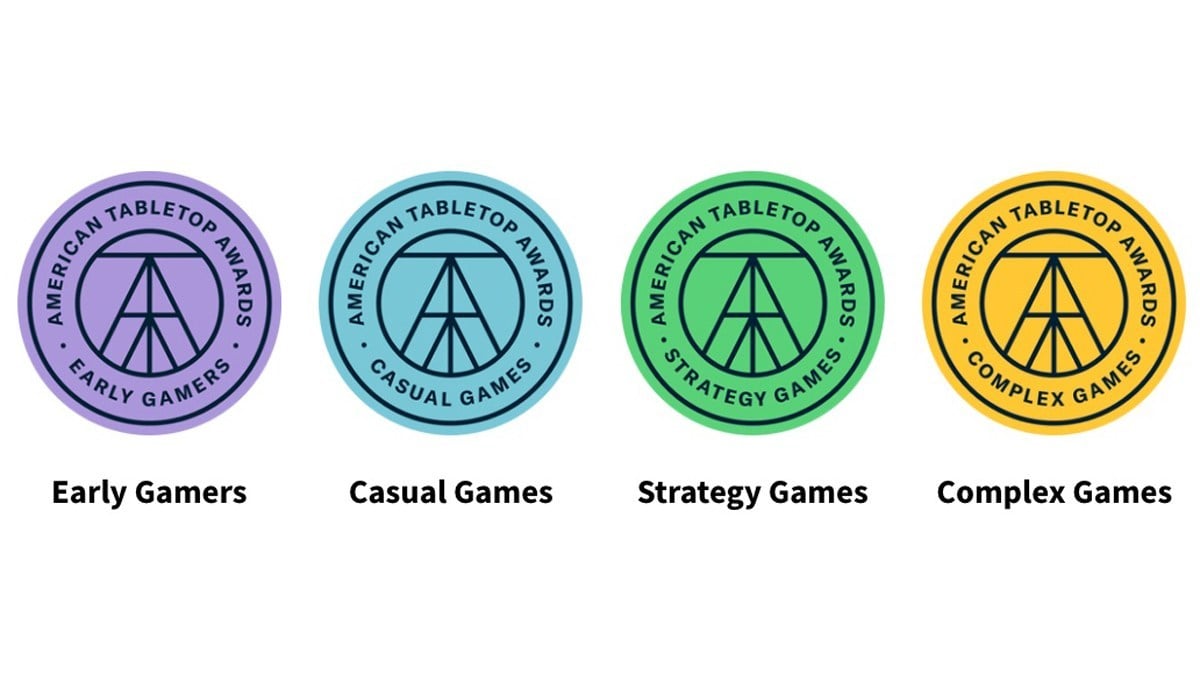In “Reaping the Rewards,” I take a look at the finished product from a crowdfunding campaign. Today’s title: Evolution: Climate, which was originally funded in March 2016, and delivered to backers in late 2016. There were limited copies available to purchase at Gen Con in 2016, but it didn’t hit store shelves until later. With this month’s Kickstarter launch of Evolution – The Video Game, I thought it might be worth taking a closer look at this analog version as well! (Note: this review is based on my original Kickstarter Tabletop Alert, modified to reflect finished components.)
The world of Evolution is heating up! Or perhaps cooling down. Either way, you need to keep an eye on the forecast, because the climate is going to have an effect on your species, and you need to be prepared.
What Is Evolution: Climate?
Evolution: Climate is a sequel to Evolution for 2 to 6 players, ages 12 and up, and takes about an hour to play. There are two versions: a stand-alone game for $59.99, and a conversion kit for those who already own the base game for $29.99. (Or, if you want to print your own copy, the stand-alone PnP is $15 and the conversion kit PnP is $5.) I’ve played the original game with kids as young as 8, and I think it’s manageable although younger kids may not get the deeper strategies immediately.
Evolution: Climate is GeekDad Approved!

Evolution: Climate Components
Evolution: Climate Stand-Alone:
- 177 Trait cards
- 30 Climate Event cards (15 Cold, 15 Hot)
- 240 Food tokens
- 20 Species boards
- 20 Population markers (green)
- 20 Body Size markers (brown)
- 6 Food bags
- 1 Climate track
- 1 Climate marker
- 1 Start Player marker
- 2 player aids
Evolution: Climate Conversion Kit (if you already own the base game):
- 86 Trait Cards
- 1 Climate Track
- 1 Climate Marker

The quality of the components in previous Evolution games has been excellent–you can see more photos of the finished base game in my “Reaping the Rewards” post about it. What’s new this time around are some added Trait cards and the Climate Track. Some of the cards are the same Traits as before, but with added text that applies to the Climate rules, while others (like “Heavy Fur” and “Cooling Plates”) are brand-new.
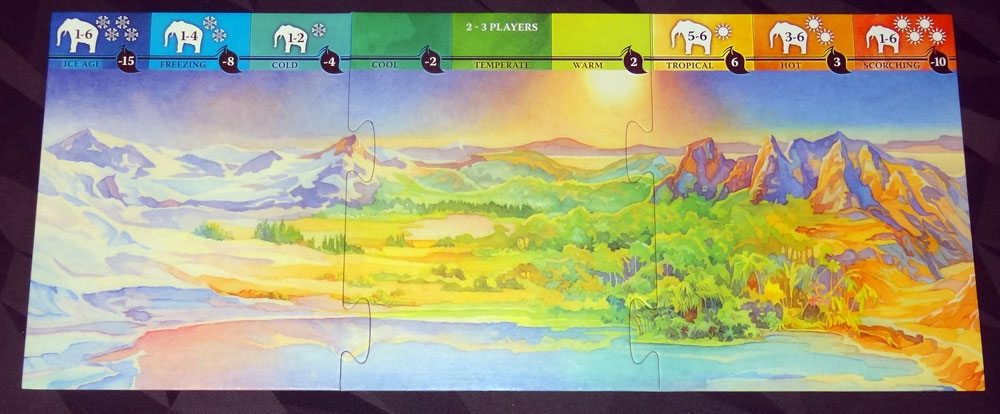
The Climate Track is a wide board, double-sided with slight differences based on the number of players, and it’s made of three large puzzle pieces. The Track goes from “Ice Age” to “Scorching,” and each space on the zone lists the effects of that temperature: every space except Temperate will affect the amount of plant food available for the round, and all but the three white in the center will also cause certain species to lose population. One odd thing about the track is that if you place the climate marker on the space itself, it covers up the population effects of that space.
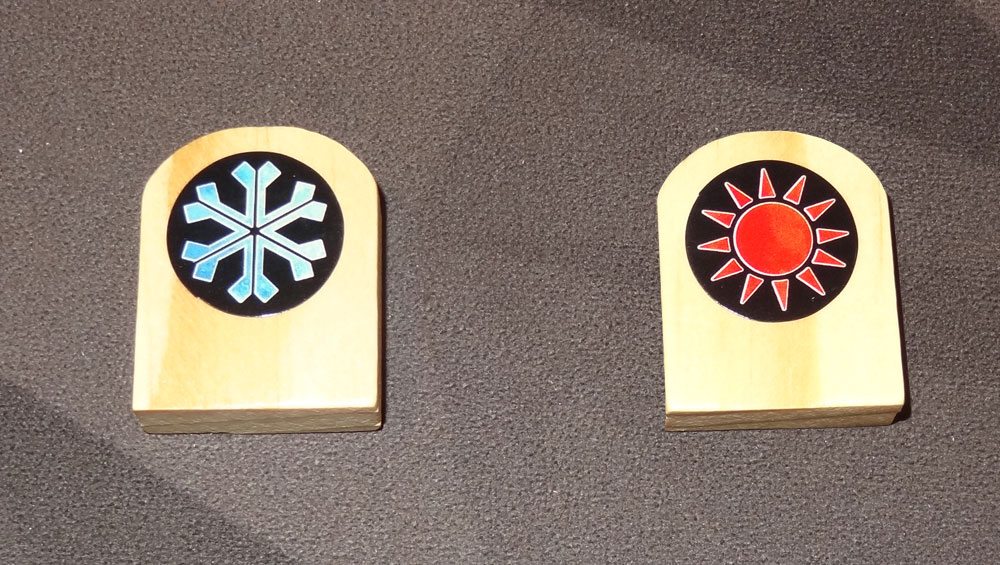
The Climate Tracker is a tombstone-shaped (foreshadowing?) wooden token; you get a snowflake sticker and a sun sticker to put on either side. While the stickers aren’t entirely necessary, you can flip the token around as it goes up and down the climate track just to remind everyone of the current climate.
The backs of the “hot” and “cold” Climate Event cards are not labeled with text, but instead have a section of the artwork from the Climate Track board, so that you can place them on the board and they match the background. I thought it was strange at first that there aren’t spaces marked for the cards, but I like the fact that the artwork isn’t marred by any text or iconography.
The artwork in the game is by Catherine Hamilton, who illustrated the rest of the series, and I just love her watercolor paintings.
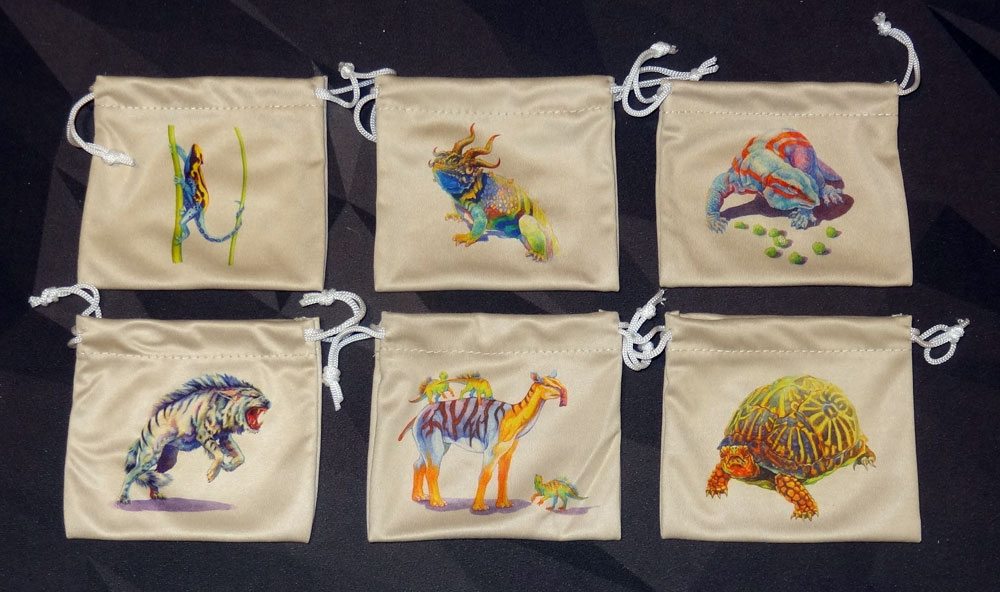
The first player marker is an enormous dinosaur meeple, which is really fun to pass around. The food bags are nice, soft cloth with some of Hamilton’s artwork on them. The box insert is pretty well done, with dedicated spaces for most of the components, though the food tokens are just sort of put into a card well, it seems.
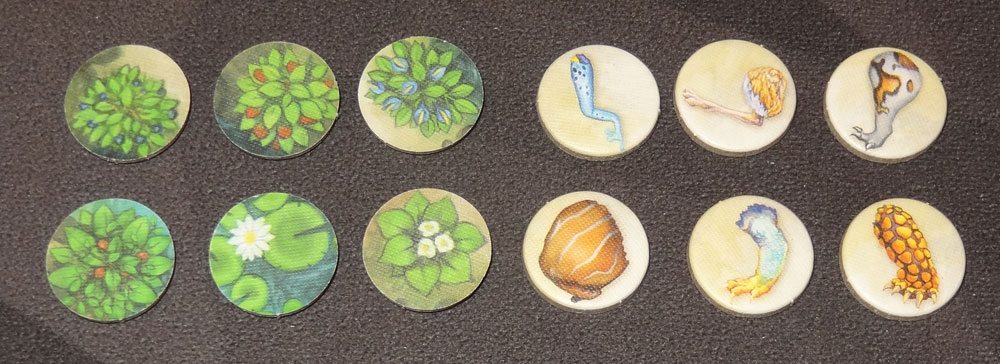
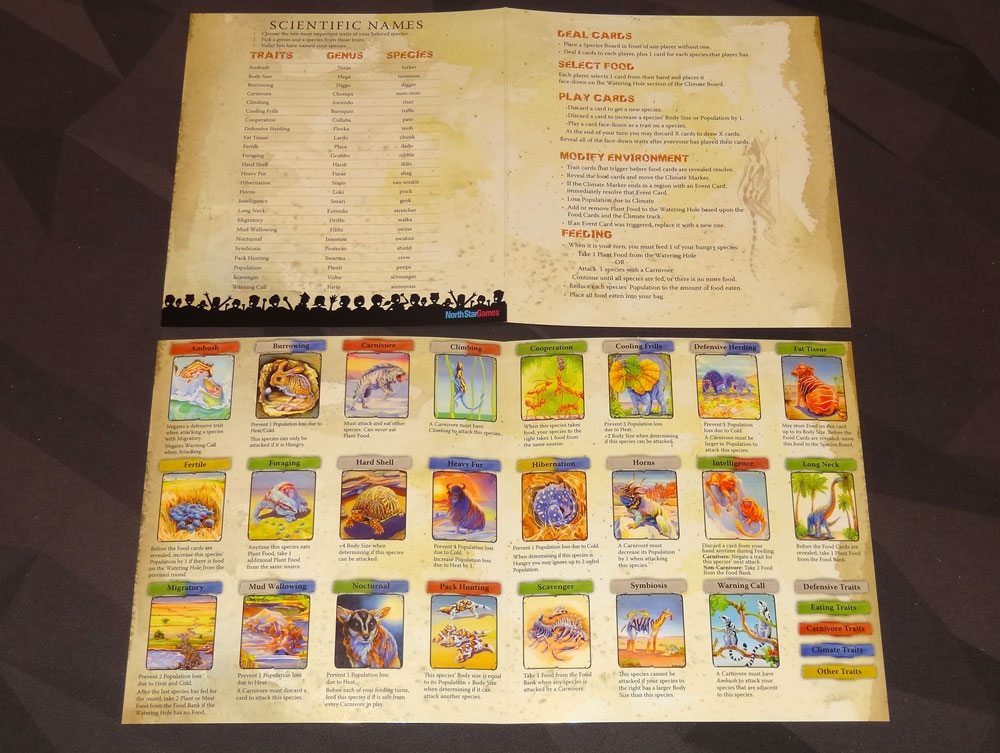
The player aids are laminated sheets with a couple things on them: a turn order reminder, a two-page spread showing all of the traits and what they do (as well as a key explaining the color coding for the traits), and then a chart of “scientific names” that give you genus and species names based on the traits. For instance, my Pack-Hunting Carnivore could be called a Swarma nom-nom.
My only real complaint is that I’m not a fan of the quality of the cards–they’re a glossy finish, and tend to clump a little when you shuffle and deal them.
How to Play Evolution: Climate
You can watch this How to Play video, or download the rules for the base game here.
Since I’ve explained the gameplay in my original review, I won’t get into too much detail here. The basic idea is to score the most points by the end of the game–you get points for food eaten during the game, and the population and Traits of all of your species surviving at the end of the game.

Throughout the game, you use Trait cards in several ways: you can add them to your species, discard them to increase your population or body size, or discard them to begin new species. Every round, each player also must contribute one Trait card to the food supply (although some cards have negative numbers, so they actually decrease the amount added). After the evolution phase of the game, a feeding phase takes place, where you take turns feeding your species, either by eating plant food from the watering hole or attacking other species with your carnivores.
In Climate, there are a few changes to the game, though nothing too complicated.
First, you get one more card per player than in the base game: each round, you’ll be dealt 4 cards plus 1 per species. Each species may now have up to 4 Traits instead of 3 (except in a 2-player game, in which the maximum is 3).
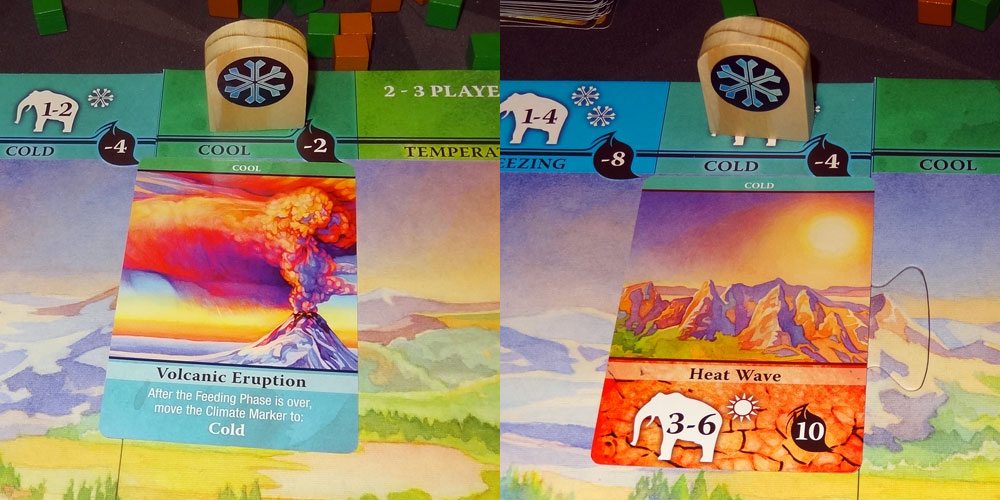
Climate Track
The big difference, of course, is the Climate Track. At the beginning of the game, the marker starts at “Temperate” in the center of the track. Many of the trait cards now have sun or snowflake icons near the food number. When the food supply cards are revealed, you first count up the suns and snowflakes. If there are more suns, the climate gets warmer; more snowflakes and it gets colder. (Same number, and the climate doesn’t change.)
After the climate has been determined, you determine whether any species suffer population loss. When it gets hot, bigger animals start dying first; even hotter and smaller animals die, too. When it gets cold, small animals die off first, and so on. The number of population lost per affected species also increases when the temperatures get more extreme. This is where your Traits come in. Many of the Traits will protect your population from heat or cold by reducing the number that you must kill off.
After dealing with population loss and Events, you count up the food on the cards, and then add or subtract the number shown on the current climate space. That tells you how much plant food to add to (or remove from) the watering hole. The colder it gets, the less food there is. When it gets warmer, you get more plant food… up to a point. When it’s “Hot” or “Scorching,” the food dries up pretty quickly.
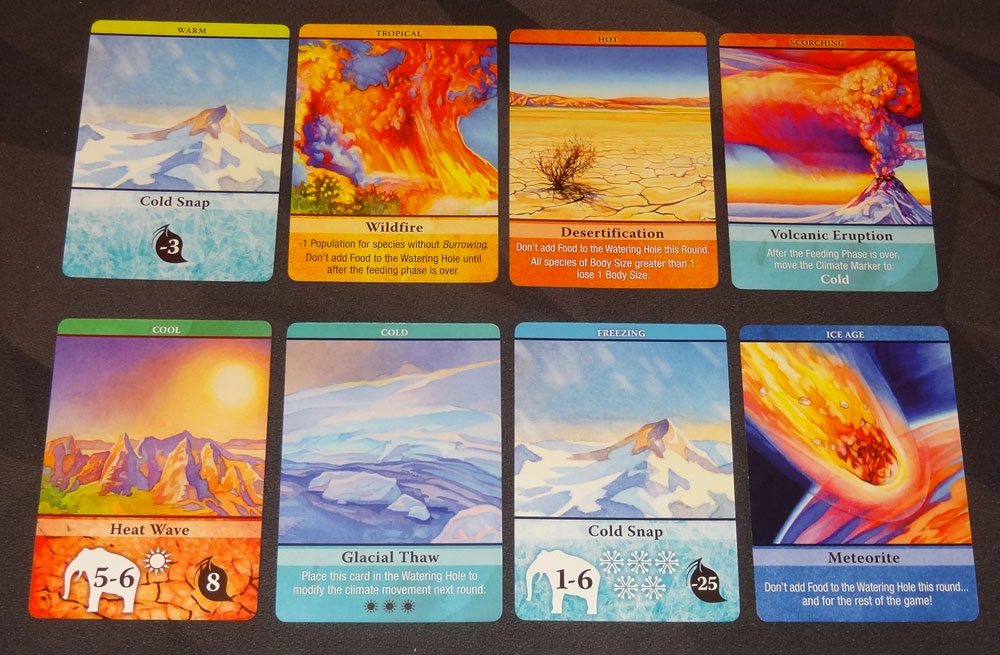
Climate Events
The Climate Events, which were added during the Kickstarter campaign as a stretch goal, introduce some additional effects that the climate may have. When setting up, you shuffle the two decks–hot and cold events. Reveal one of each, and place them on the board below the climate spaces indicated at the tops of the cards. The events will trigger if the climate reaches that space. So, for instance, you might get a “Cold Snap” event if the climate reaches “Warm” or “Tropical.” The cards are placed on the matching spaces.
If you trigger a Climate Event, discard it and then draw a new card from that deck, placing it in the appropriate zone. Only one event will trigger per round.
The rest of the game proceeds as normal–players take turns feeding their species until everyone is full or the food runs out. Then, starving population is lost, the food is placed into the bags, and everyone gets new cards for the next round.
The game end is triggered when a certain number of cards has been used, indicating that it’s the last round. At the end, everyone gets 1 point per food, surviving population, and surviving Trait.

Why You Should Play Evolution: Climate
If you haven’t played the original Evolution yet, you’re really missing out on something great. It’s definitely a game that rewards repeated play, because as you become familiar with the various traits available in the game, you can build some very interesting creatures. I also love that it’s not a game that rewards one particular tactic every time–your success with any given combination of traits really depends on the entire ecosystem: how much plant food is there? Are there predators? If so, what traits do they have?
The Climate expansion introduces one more factor into the ecosystem, and I think it’s a nice upgrade that adds to the flavor and theme without throwing in too many new rules. Essentially, you know that in any round, the climate can change up to 1 space in either direction, getting warmer or colder. And since the climate moves according to the food supply cards, you do have some limited control over it. If you really don’t want the climate to get warmer, throw in that card with 3 snowflakes on it.
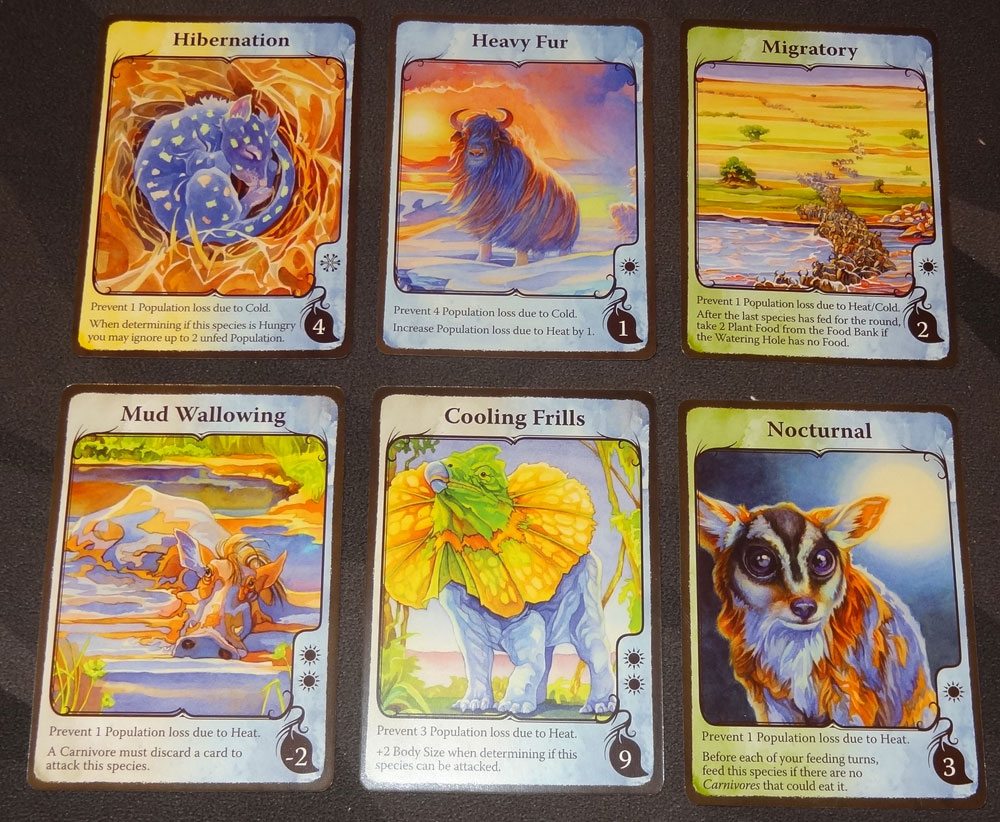
The climate effects also make you think about how to use your Trait cards. For instance, if you think it’s likely that it’s going to get colder (where smaller animals lose population first), then you probably want to increase body size if you don’t have any cold protection. That’s a mistake several of us made the first time I played the game–we all put in snowflake cards, the temperature dropped, and all species with body size 1 lost population. Well, none of us had increased population or body size, so several species went extinct in the first round. We learned that particular lesson quickly.
Once your species have some protective Traits, though, you’ll have an idea of which way you want to move the climate. Carnivores, who often have larger body sizes anyway, are happy to move toward colder climates: not only do the smaller animals freeze to death, but there won’t be much plant food for the survivors, either. On the other hand, if you’re a tiny plant-eater, you’re happy to move the temperature up–maybe that nasty carnivore will die of heat stroke.
When you first get started, though, most players will probably try to stay near the temperate climate, simply because those Climate Events are so scary, and because people are worried about population loss due to climate. In the games I’ve played so far, we trigger only a few events throughout the whole game. Desertification, in particular, was so terrifying that nobody wanted it to happen, and everyone cooperated in contributing snowflake cards to avoid it. And we haven’t even gotten to the meteor strike.

I could see that Climate could allow you to play Evolution much more aggressively, with a lot more extinction and potentially lower scores for everyone–but, again, that will take some time and experience so everyone is familiar with the types of traits available.
I’ve always liked the mix of traits and the thematic effects, and the new cards continue that trend. Migratory creatures get protection not only from the climate but can also find food elsewhere if the watering hole runs dry–but they’re also more vulnerable to carnivores with Ambush. Hibernation gives you protection from cold and starvation. Some of the climate-protection Traits, like Heavy Fur and Cooling Plates, also make you appear larger to predators, while Defensive Herding has been updated to provide protection from cold. There are six new traits in Climate, and then a few traits that have been updated with climate-related effects.
I did like the Flight expansion to Evolution, but I felt it did make the game quite a bit harder. Many people tried to create flying species that then went extinct because they didn’t account for how much food they’d need to eat, and the learning curve was a bit harder. Climate seems to have an easier learning curve compared to Flight, because the weather affects everyone, and many of the traits that provide weather protection also have other effects as well. (Note: currently you can play with one expansion or the other; Flight is not compatible with Climate.) The Climate rules are easy enough that you can teach the game with Climate right from the start, though I like that you could also play “classic” Evolution with the stand-alone game if you want.
I can’t say enough how impressed I’ve been with the Evolution game series, and I highly recommend taking a look at Climate. If you’re already a fan of Evolution, you’ll definitely want to add this to your set. If you haven’t played with the expansions yet, I would recommend trying out the Climate expansion first and saving Flight for later if you enjoy the game.
Click here to see all our tabletop game reviews.
Disclosure: GeekDad received a copy of this game for review purposes. Note: Although North Star Digital purchased ads for their Evolution – The Video Game Kickstarter campaign, there was no financial compensation for this review.
